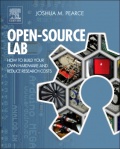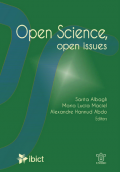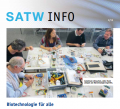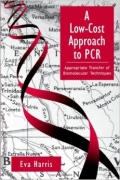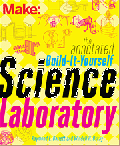Generic Lab Equipment
Contents
Links to projects for making your own lab equipment on the hackteria wiki
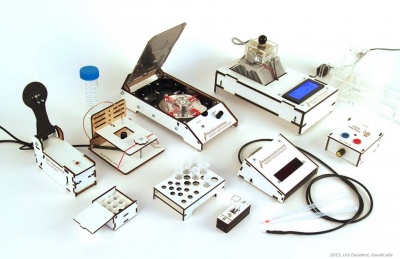
To start up an independent and open lab it is crucial to get affordable lab equipment (besides having an enthusiastic and open group of people, see Bio Lab Infrastructure). Most of the tools we use are do it your self (DIY) and open source and are built from widely available and recycled parts found in consumer products such as DVD drives, hard disks and pc fans. Building the specific devices further helps to understand the basic principles behind and learn more about the technologies and methods used. The discussions among scientists and engineers in the process of rethinking the devices to make them more accessible are very fruitful and often lead to new and innovative designs. - Urs Gaudenz
Lab tools
- DIY microscopy - One of the basic tool, made from a hacked webcam, a must for every DIY biolab, science outreach, citizen science or bio-VJ tool
- Hacked Hard-disc Centrifuge - 3D printed eppendorf tube holder and motor controller for the hacked hard-disc. And a case!
- DIY Incubator - keep things warm and cozy
- DIY handheld centrifuge - use of a mixer and a tube holder... sligthly dangerous
- DIY Water Bath - always needed to keep stuff warm
- Wild openQCM - Quartz crystal microbalance
- DIY turbidity meters also known as spectrophotometers
- Wild OpenPCR – How to build a PCR thermocycler
- Elektrowetting - The basics and OpenDrop – Digital Microfludics Plattform
- DIY Sterlisation Hood -
- Iyok's Parametrized TubeRack
- DIY spectroscopy a low cost yet quite functional 3D printed spectrometer with an optical fiber link. More on GaudiLabs
Related projects
- Bio Lab Infrastructure gives a more general introduction into initiating a bio-lab, including some conceptual approaches around people over infrastructure, some lists and experiences from earlier projects.
- BIO-reSEARCH is part of Pechblenda tentacles, mixed with AnarchaGland & GynePUNK biolabs research.
- Open Source Lab Equipement by GaudiLabs
- biodesign for the real world a collaborative project on open source hardware for education and citizen science see more on the Biodesign.cc website
- Understanding Open Hardware and Citizen Science, a new network of enthusiasts from Nepal, Indonesia and Thailand, working on various DIY lab tools for real world applications and south-to-south collaboration Open Hardware Bootcamp wiki
- SATW-DIY: Biotechnology for all / DIY in bioanalytics Co-Development of a workshop on DIY laboratory instruments for bioanalytics, colorimetry, low-cost microcontrollers and simple DIY electronics, enzymatic assays. With a concept of "teach the teachers", we are looking into DIY lab-tools as means of a pedagogic tool for interdisciplinary thinking at the biomedical/engineering/molecular interface. Coproduced with SATW, Hackteria and FHNW. See the Publication and more info.
- The HTGAA (How To Grow Almost Anything) is a part of the growing Academy of (almost) Anything, or the academany. HTGAA is a Synthetic Biology Program directed by George Church, professor of Genetics at Harvard medical school. How To Grow a Lot at GaudiLabs & Download backup of Gaudi's Final Project: Setting up a microbiology lab
Slideshows
Important Readings
- Beyond Black Boxes by Resnick, et al
We present a set of case studies in which students create, customize, and personalize their own scientific instruments – and thus become engaged in scientific inquiry not only through observing and measuring but also through designing and building. While computational technologies have, in general, contributed to making today’s scientific instruments more “opaque ” (that is, less understandable) and less aesthetically-pleasing than their predecessors, we argue that these same technologies can be used to bring back a sense of transparency and aesthetics to the design of scientific instruments. We analyze how students, by building their own scientific instruments, can: pursue a broader range of scientific investigations of their own choosing, feel a stronger sense of personal investment in their scientific investigations, and develop deeper critical capacities in evaluating scientific measurements and knowledge.
Constructionist approach. In most MBL activities, students use pre-built instruments; similarly, many “home science” books focus on pre-designed demonstrations and experiments. BBB activities take a different approach: students are encouraged to construct and program the instruments that they use – and to design their own experiments.
Syntheses of "Beyond Black Boxes" put together by dusjagr and discussions with all of you.
- Open-Source Lab by J. Pearce, et al.
Pearce, Joshua. 2013. “Open-Source Lab: How to Build Your Own Hardware and Reduce Research Costs”. 1 edition. Amsterdam; Boston: Elsevier.
This guide details the development of the free and open-source hardware revolution and provides you with step-by-step instructions on building your own laboratory hardware.
See more on Appropedia Open-Source Lab
- Lab Making | The Book: HackteriaLab 2014 - Yogyakarta, by Urs Gaudenz, Sachiko Hirosue
"Making a Laboratory is both a spontaneous activity and a slow labor of love."
A Lab is a place to labor (not only of love), experiment, research and share - there is no labor, experiment, research or sharing without the people. A Lab is not a museum for journalists, but a place made by a person for other people Start a small Lab , put it in a box, suitcase, backpack, picnic basket and take it with you. A Mobile Lab it actually allows you to go to people, and not wait for the others to come.
- Gaudi's Final HTGAA Project: Setting up a microbiology lab, by Urs Gaudenz, Stefan Deuber
To goal of the HTGAA final project is to equip and start a microbiology lab as part of GaudiLabs. Microbiology, the study of microscopic organisms and cells, synthetic biology, the interdisciplinary branch of biology and engineering are exciting fields of science that with the DIYBio and hackteria.org movement step out of the institutional scientific labs into society. Now still a lot of requisites to do micro biology at home are hard to get or too expensive. With this project we want to find ways to set up a microbiology lab with low cost DIY lab equipement and materials readily available from local stores or from the internet. We take the first steps towards a functional biolab for synthetic biology by preparing bacterial stock from simple or adapted protocols.
Download .pdf backup of Gaudi's Final Project: Setting up a microbiology lab
- Open Science, open issues by Sarita Albagli, et al.
This book brings contributions by researchers from different areas and a wide range of countries, including Brazil, who have a significant role and reflection in the field of open and collaborative science.
The topic of open science is gaining ground not only within institutional environments for science, technology and innovation, but also in other contexts that, until now, were kept apart from these activities. As a result, it is mobilising other social groups as interlocutors of scientific practices. In turn, the resulting transformations in the relations between science, technology and society integrate the new dynamics of production and circulation of knowledge as well as the new role played by these dynamics in contemporary processes of social participation and change.
It is hoped that this publication will provide an overview of topics and issues that both trace and permeate the topic of open science nowadays from different perspectives and points of view. Above all, it is hoped that it might instigate further reflection and foster new ways of producing and circulating knowledge. Thus, it is geared not only towards the academic world, but also to abroader range of social actors that concern themselves with the democratisation of knowledge and information. The book is inspired by the results of the discussions held during the International Seminar “Open Science, Open Questions” that took place in Rio de Janeiro in 2014.
The Seminar was organised by: the Brazilian Institute for Information in Science and Technology (IBICT), Open Knowledge Brasil (OKBr), the Federal University of the State of Rio de Janeiro (Unirio) and the Interdisciplinary Laboratory for the Study of Information and Knowledge (Liinc). We would like to thank Ibict, Unirio, the Brazilian Center for
Edited by Sarita Albagli, Maria Lucia Macie, Alexandre Hannud Abdo
Here you can download the full book
- Open source hardware (OSHW) for open science in the global south: geek diplomacy? by Denisa Kera, excerpt from book above
The Do-It-Youself biology (DIYbio) movement originated in the U.S. in approximately 2009 around student iGEM synthetic biology competitions as well as parallel open biology efforts in Europe and Asia with their connections to bioart and critical science practices in the late 1990s. This movement merged in recent years with other movements coming from professional scientists advocating eScience, Open Science, Open Access and Open Data. The calls for changing the publishing model and opening the datasets while supporting online collaboration and crowdsourcing are starting to merge with attempts to reduce the cost of experimental research and increase reproducibility by building low cost customizable laboratory equipment.
File:Open Science 2015 Kera GeekDiplomacy.pdf
Biotechnology for All / DIY in bioanalytics: doing and grasping it yourself. SATW publication 2015
SATW Info 2/15 – Biotechnology for all / DIY in bioanalytics: doing and grasping it yourself. More info here.
«Do it yourself» in der Bioanalytik – für Deutsch siehe hier, français ici.
The article from SATW Info 2/15 – Biotechnology for all / DIY in bioanalytics: doing and grasping it yourself is available for download in German, English and French. The pedagogic conecpt and educational kits were developed during a project funded by the Swiss Academy for Engineering Sciences (SATW), together with hackteria, M. Dusseiller and U. Gaudenz, and FHNW School for Lifesciences, Dr. D. Gygax, during a workshop with an interdisciplinary group of participants.
"Biotechnological research is no longer limited to specialist laboratories: a growing community of biologists, amateur enthusiasts and technophiles is experimenting in kitchens, workshops and DIY laboratories. Some people view the democratisation of biotechnology as a threat, others as an opportunity to gain a better understanding of complex scientific interrelationships within society."
"Biotechnologische Forschung findet heute nicht mehr nur in spezialisierten Labors statt. Eine wachsende Gemeinschaft von Biologen, Bastlern und Technikbegeisterten experimentiert in Küchen, Werkstätten und Eigenbau-Labors. Einige sehen in der Demokratisierung der Biotechnologie eine Gefahr; andere die Chance für ein besseres Verständnis von komplexen wissenschaftlichen Zusammenhängen in der Gesellschaft."
"Aujourd’hui, la recherche biotechnologique n’est plus l’apanage des laboratoires spécialisés. Une communauté croissante de biologistes, de bricoleurs et de passionnés de technique s’adonne à des expériences dans des cuisines, des ateliers et des laboratoires individuels. Certains considèrent cette démocratisation de la biotechnologie comme un danger, d’autres comme une chance d’améliorer la compréhension des relations scientifiques complexes au sein de la société."
politics of labs
TALs Temporary Autonomous Labs iydbiydoi if you dont build it you don't own it
Various Recent and Historic Books
Another nice list was compiled during HLab14 Library
Various from the resources of Arvind Gupta
See loads of good stuff on Arvind Gupta's Website
Low Cost Equipment for Science and Technology Eduction,
COMPILED BY UNESCO Make school science equipment using inexpensive materials.
- LOW COST EQUIPMENT FOR SCIENCE AND TECHNOLOGY EDUCATION - Vol. 1
- LOW COST EQUIPMENT FOR SCIENCE AND TECHNOLOGY EDUCATION - Vol. 2
New UNESCO Sourcebook for Science Teaching, 1973
Do It Yourself Lab Equipment
A Low-Cost Approach to PCR, Eva Harris, 1998
The polymerase chain reaction (PCR) is a technique used to replicate specific pieces of DNA millions of times, which permits the detection and analysis of minute amounts of nucleic acids. Since its introduction in the late 1980s, this technique has been applied not only in molecular biology research but also in fields as diverse as anthropology, phylogeny, and forensics. However, despite the large impact of PCR, many of its applications remain within the confines of research and the academic environment. Now, in A Low-Cost Approach to PCR: Appropriate Transfer of Biomolecular Techniques, Dr. Eva Harris makes this elegantly simple technique more accessible to researchers, physicians, and laboratory workers throughout the world. She provides a description of the theoretical basis of the technique, the practical details of the method, and the philosophy behind the technology transfer program that she developed over the last ten years.
Download File:Low cost approach to PCR - 2007.pdf
Build-It-Yourself Science Laboratory, Raymond E. Barrett, 1963 and Reprint 2015 by MAKE
Raymond E. Barrett's Build-It-Yourself Science Laboratory took on an audacious task: to show readers how to build a complete working science lab (starting with a workbench) for chemistry, biology, and physics--and how to perform experiments with those tools. The experiments in this book may appear fearless and bold by today's standards, but many from previous generations fondly remember how we as a society used to approach scientific learning. Updated for today's world with annotations and sourcing notes by Windell Oskay of Evil Mad Scientist Laboratories, prepare to read (and use) this classic to reinvigorate scientific exploration at school and at home.
- Make: The Annotated Build-It-Yourself Science Laboratory: Build Over 200 Pieces of Science Equipment! for download
Links to other pages
Appropedia
Appropedia - Building research equipment with free, open-source hardware
Most experimental research projects are executed with a combination of purchased hardware equipment, which may be modified in the laboratory and custom single-built equipment fabricated inhouse. However, the computer software that helps design and execute experiments and analyze data has an additional source: It can also be free and open-source software (FOSS). FOSS has the advantage that the code is openly available for modification and is also often free of charge. In the past, customizing software has been much easier than custom-building equipment, which often can be quite costly because fabrication requires the skills of machinists, glassblowers, technicians, or outside suppliers. However, the open-source paradigm is now enabling creation of open-source scientific hardware by combining 3D printing with open-source microcontrollersW running on FOSS. These developments are illustrated below by several examples of equipment fabrication that can better meet particular specifications at substantially lower overall costs.
BioHack Academy
BioHack Academy - Waag Society, Amsterdam and global
The age of personal biotechnology is upon us! Engineers have turned biology in a design discipline and it's now up to us to shape it's applications. After completing the BioHack Academy you can grow your own fuel, food, filaments, farmaceuticals, fragances, fungi and much more funky bio stuff at home. We'll teach you how to join the bio revolution and build your own biofactory using a Fablab, Maker/Hackspace or other shared machine shop.
Learn how to design, grow and extract your own biomaterials using only Open Source hardware you fabricate yourself. Whether it's a new type of bio ink, bio polymer or bio fuel, we'll show you can grow it yourself and share the results with others.
GOSH!
Gathering for Open Science Hardware
A growing number of people around the world are developing and using Open Science Hardware, and we want to help build a coherent, self-organising community to raise its profile and drive change within institutions to increase uptake and opportunities.
GOSH! 2016 will bring together 50 of the most active developers, users and thinkers in the Open Science Hardware space complemented by expertise from diverse, related backgrounds to seed just such a community. We aim to learn and build together, scoping the potential of the field and planning our way to implement change.
This is intended as the first of a series of meetings that we hope to grow alongside the developing community – watch out for GOSH! 2017.
The Global Open Science Hardware (GOSH) movement seeks to reduce barriers between diverse creators and users of scientific tools to support the pursuit and growth of knowledge. See also The Global Open Science Hardware (GOSH).
PLOS Collections
PLOS Collections: Open Source Toolkit: Hardware
The Open Source movement revolutionized the way computer systems were developed and how companies made their businesses. Its philosophy requires that all source code should be freely shared, so that as many people as possible can use, change, learn, and improve upon it. In recent years the increasing availability and low costs of electronic components, processors and 3D printers meant that an open model of development has taken root also in the world of hardware, including the development of scientific lab equipment. The implications for research can hardly be overstated: “Open Labware” designs are almost always cheaper than “closed source” ones, allow for distributed development and, critically, customization by the end user, the lab scientist. PLOS welcomes submissions in this field.
synbiolab
symbiolab by IRNAS - Maribor
One of our goals at symbiolab is making a complete collection of affordable and DIY laboratory equipment, which is required for common methodology in a biological research lab. To do this, we will begin by making a list of required equipment, describing the hardware, its use, commercial costs and the current DIY status. This list will include links to some DIY examples, it will however not contain actual plans for our designs, this will come later (there will be links though, once available). To make the content more legible, the equipment will be organized into categories, such as preparation, microscopy, chromatography, proteomics,...
Spiderwort
SPIDERWORT - A MISSION DRIVEN COMPANY DEVELOPING OPEN SOURCE PLATFORMS FOR BIOLOGICAL RESEARCH
We have witnessed how scientific advancement is often confronted by problems stemming from inadequate funding to acquire basic technologies or the lack of time and expertise needed to build such platforms from scratch. During own research endeavours we have developed several open source platforms for conducting scientific research on mammalian cells and tissues. Although we have already freely shared these platforms with the community, there have been many requests for us to develop open source kits that could be used in schools, labs and garages.
Open-Labware.net
Open-Labware.net | 3-D print your own lab equipment
The introduction of affordable, consumer-oriented 3-D printers is a milestone in the current “maker movement,” which has been heralded as the next industrial revolution. Combined with free and open sharing of detailed design blueprints and accessible development tools, rapid prototypes of complex products can now be assembled in one’s own garage—a game-changer reminiscent of the early days of personal computing.
It therefore comes as no surprise that more and more researchers are beginning to integrate the possibilities offered by 3-D printing and off-the-shelf electronics into their own lab routines, be it to modify existing equipment or to build new tools from scratch. The results are typically published under an Open Source licence in online repositories such as thingiverse, instructables or Hack-a-day. More mature projects are often also submitted for publication in international peer reviewed open access outlets such as PLoS, Frontiers, eLife or Nature Communications.
PublicLab
Public Lab
Public Lab is a community where you can learn how to investigate environmental concerns. Using inexpensive DIY techniques, we seek to change how people see the world in environmental, social, and political terms.
Public Lab is an open community that anyone can join. We work online through this interactive wiki where people can pose

